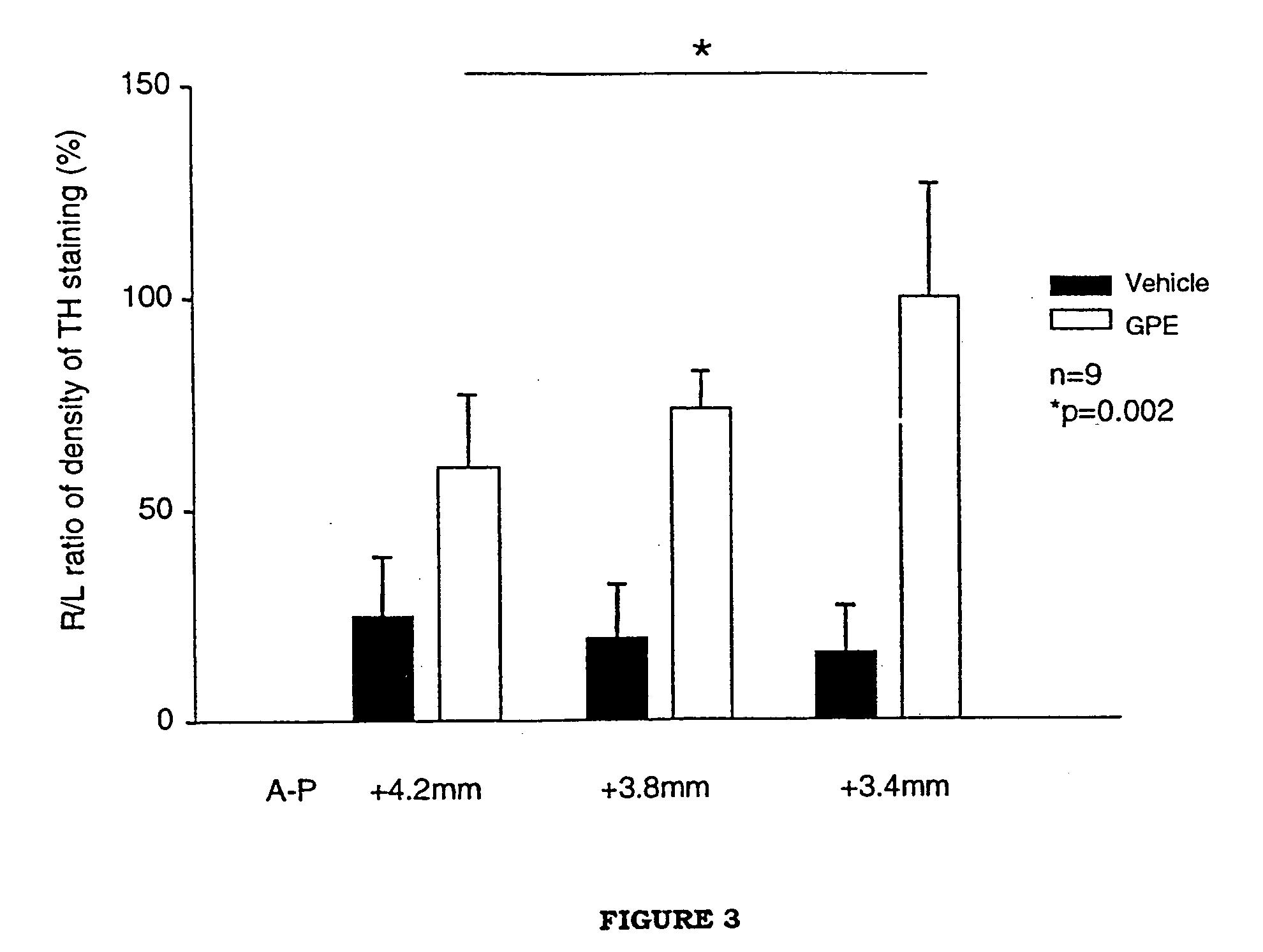Regulation of tyrosine hydroxylase by gpe
a technology of tyrosine hydroxylase and gpe, which is applied in the direction of drug composition, peptide/protein ingredients, metabolic disorders, etc., can solve the problems of limited and transient efficacy, no teaching or suggestion of gpe or its analogs having any direct effect on the effective amount, and no drugs currently available to intervene in the disease process
- Summary
- Abstract
- Description
- Claims
- Application Information
AI Technical Summary
Benefits of technology
Problems solved by technology
Method used
Image
Examples
example 1
[0040] This experiment was blind with respect to the treatment (with GPE or the vehicle) and with respect to the counting of neurons expressing TH (between sections from animals treated with GPE or vehicle).
[0041] The objective of this experiment was to determine the effects of administering GPE on the expression of tyrosine hydroxylase (TH) in the presence or absence of CNS injury. The experiment involved treating the rats with a control vehicle or GPE 2 hours after a chemically induced lesion in the substantia nigra region of the brain. Specifically, 9 pairs of adult male Wistar rats (280-320 g) were prepared under 3% halothane / O.sub.2 anaesthesia. The oxygen free radical producing neurotoxin 6-hydroxydopamine (6-OHDA) which produces degeneration of dopamine neurones (8 .mu.g / 2 .mu.l) was injected into the median forebrain bundle using a 30 gauge needle (coordinates: anterior-posterior+4.7 mm, right+1.6 mm, vertical-8.5 mm). A guide cannula was placed on the dura 7.5 mm anterior f...
example 2
[0045] Example 2 was performed using a second set of rats (9 pairs), using the same experimental parameters except that only the immunopositive neurons at 2 levels of the SNc were counted.
[0046] The results are shown in FIG. 2, and again demonstrated upregulation of TH expression.
example 3
[0047] Ethics Approval
[0048] These experiments were approved by the University of Auckland Animal Ethics Committee and all efforts were made to minimise the suffering incurred and the numbers of animals used.
[0049] Experimental Design and Animal Preparation
[0050] A paired experimental design was used and the experimenter was blinded to the treatment groups. Eighteen male Wistar rats (50-60 days old, 280-310 g) were used for this study. 6-hydroxy dopamine (6-OHDA) was prepared as .sup.8 .mu.g in a base of 2 .mu.l 0.9% saline containing 1% ascorbic acid. It was administered into the right medial forebrain bundle (MFB) using coordinates of AP+4.7 mm, R 1.6 mm, V-8 mm under anaesthesia of 3% halothane. 6-OHDA was injected into the right MFB using a Hamilton syringe (100 .mu.l with a 30G needle) controlled by a microdialysis infusion pump at an infusion rate of 0.2 .mu.l / minute. The infusion needle was then slowly withdrawn 5 minutes after the infusion. The surgery and procedures for the...
PUM
| Property | Measurement | Unit |
|---|---|---|
| weight | aaaaa | aaaaa |
| weight | aaaaa | aaaaa |
| temperature | aaaaa | aaaaa |
Abstract
Description
Claims
Application Information
 Login to View More
Login to View More - R&D
- Intellectual Property
- Life Sciences
- Materials
- Tech Scout
- Unparalleled Data Quality
- Higher Quality Content
- 60% Fewer Hallucinations
Browse by: Latest US Patents, China's latest patents, Technical Efficacy Thesaurus, Application Domain, Technology Topic, Popular Technical Reports.
© 2025 PatSnap. All rights reserved.Legal|Privacy policy|Modern Slavery Act Transparency Statement|Sitemap|About US| Contact US: help@patsnap.com



